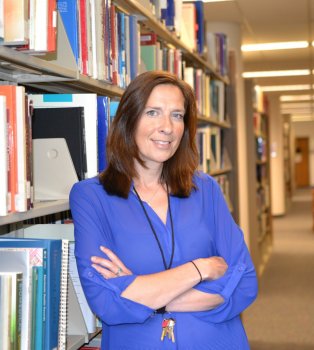Lynn Ulatowski, Ursuline College – The Concept of the Big Picture
 How do we get students to look at the big picture?
How do we get students to look at the big picture?
Lynn Ulatowski, assistant professor of biology at Ursuline College, describes one method to do so.
Lynn Ulatowski earned a BS in Molecular Biology/Biotechnology from Westminster College in New Wilmington, PA. She earned an MS in Nutrition and a PhD in Molecular Nutrition, both from Case Western Reserve University. Her Dissertation topic was: Regulation of Vitamin E and Tocopherol Transfer protein, for which she received the Academic Excellence Award. As a Post-doctoral fellow, Dr. Ulatowski researched Vitamin E transport in the central nervous system, which is particularly relevant to oxidative stress associated diseases like Alzheimer’s disease, amyotrophic lateral sclerosis, and Down Syndrome. Her research also includes delineating how modifications of Tiam1 GEF influences activation of Rho GTPases and progression of colon cancer.
The Concept of the Big Picture
How often do students come in with a stack of index cards and say “look how much I studied”. There is a place for note cards and rote learning but students can be encouraged to take those index cards to the next level. One way to do this is by using a concept map strategy. A concept map is a graphical method that allows students to start with core ideas and essentially build and link from those main ideas to related topics. A concept map not only allows students to summarize, visualize and organize but importantly it encourages students to step away from linear learning and examine the big picture. Often time students do not realize how concepts and ideas fit together and impact each other.
However it is important for students to recognize how a topic fits in to a bigger perspective because it helps them to learn, apply and understand why something matters and gives the information added value. There are numerous methods of concept mapping to use. For students that have that stack of index cards, they can spread them out on a table, like a puzzle to see how things are related.
Alternatively, one can use an “old school” paper and pencil method, because as research demonstrates, writing something down promotes and reinforces learning. A fun method for students is to use a chalkboard or a dry erase board. For the more tech savvy students, there are numerous free concept map apps that have the benefit of always being accessible, added to and saved right on the phone. Whichever method of concept mapping a student chooses, the concept will take students from just remembering to a more complex level of learning.



My Wife was diagnosed with ALS (Lou Gehrig’s Disease) when she was 72 years old 4 years ago. The Rilutek (riluzole) did very little to help her. The medical team did even less. Her decline was rapid and devastating. Her arms weakened first, then her hands and legs. Last year, a family friend told us about Organic Herbal clinic and their successful ALS TREATMENT, we visited their website www. organicherbalclinic. com and ordered their ALS Formula, i am happy to report the treatment effectively treated and reversed her Amyotrophic Lateral Sclerosis (ALS), most of the symptoms stopped, she is able to walk and eat well, sleep well and exercise regularly., she is pretty active now and her attitude is extremely positive.
My Mother was diagnosed with ALS in 2018 following a year of doctor visits and tests aimed at finding a cure for her slurred speech, difficulty swallowing, and weakening limbs. By the time she was diagnosed, she had developed pneumonia and was put on a respirator. A family friend visits us and told us about Solution Health Herbal Clinic and their successful ALS TREATMENT, We visited their website http://solutionhealthherbalclinic.com and ordered their ALS/MND Formula which they sent through courier service to us, i am happy to report the treatment effectively treated and reversed her Amyotrophic Lateral Sclerosis (ALS), most of the symptoms stopped, she is able to walk and able to ride her treadmill again, she is pretty active now and can do everything again, Thanks to info@solutionhealthherbalclinic.com